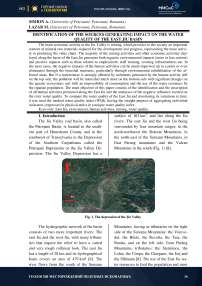Identification of the sources generating impact on the water quality of the East Jiu basin
Автор: Simion A., Lazar M.
Журнал: Горные науки и технологии @gornye-nauki-tekhnologii
Рубрика: Геология месторождений полезных ископаемых
Статья в выпуске: 2, 2018 года.
Бесплатный доступ
The main economic activity in the Jiu Valley is mining, which provides to the society an important content of mineral raw materials required for the development and progress, representing the main activity in producing the value chain. The majority of the mining activities and other economic activities deployed along the basin of the East Jiu generates both negative environmental impacts (more or less serious) and positive impacts such as those related to employment, staff training, creating infrastructures etc. In the most cases, the negative impacts of the human activities can be much improved up to a point or even eliminated through the remedial measures, particularly through environmental rehabilitation of the affected areas. But if a watercourse is strongly affected by sediments generated by the human activity still on the top side, the pollution will be intensifed much more on the bottom side with signifiant changes on the aquatic ecosystems and with an impossibility of consumption and the use of the water resources by the riparian population...
East jiu, environment, human activities, mining, water quality
Короткий адрес: https://sciup.org/140239862
IDR: 140239862 | DOI: 10.17073/2500-0632-2018-2-34-40
Текст научной статьи Identification of the sources generating impact on the water quality of the East Jiu basin
The Jiu Valley coal basin, also called the Petroşani Basin, is located in the southern part of Hunedoara County and in the southwest of Transylvania in the Depression of the Southern Carpathians called the Petroşani Depression or the Jiu Valley Depression. The Jiu Valley Depression has a surface of 163 km2, and lies along the Jiu rivers: The east Jiu and the west Jiu being surrounded by four mountain ranges: in the north-northwest the Retezat Mountains, in the north-east of the Sureanu Mountains, in East Parang mountains and the Valcan Mountains in the south (Fig. 1) [8].
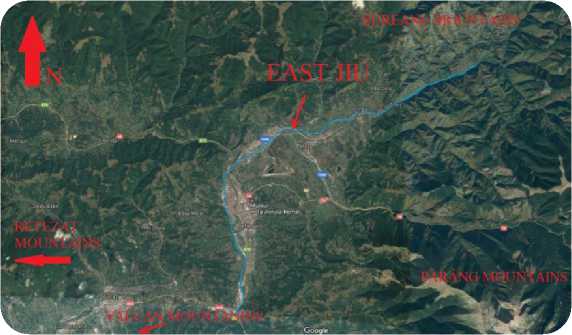
Fig. 1. The depression of the Jiu Valley
The hydrographic network of the basin consists of two more important rivers: The east Jiu and the west Jiu, with many tributaries that require the relief to have a varied and very rough collinear look. The east Jiu has a length of 28 km and its hydrographical basin covers an area of 479 km² [8]. The river flows from the south of the Sureanu
Mountains, having as tributaries on the right side of the Sureanu Mountains: the Voievo-dul, the Bilele, the Revolta, the Taia, the Banita, and on the left side, from Parâng Mountains, tributaries: the Sterminos, the Lolea, the Cimpa, the Giorganu, the Jieţ and the Slătioara [8]. The use of the East Jiu water resources to feed the population and meet
МИСиС
the socio-economic needs of the areas is strongly influenced by the water quality. The physicochemical and geological conditions determine the formation, the regime and the qualitative state of the natural water resources (6). Water is an environment with an universal spread that maintains and condition life. In order to determine the quality of surface water the following steps must be observed: selecting relevant quality indicators, establishing a rigorous monitoring program, permanent control of the main sources of pollution.
2. Impact sources
Water pollution means the direct or indirect (as a result of human activity) leakage of some substances or heat that can harm human health as well as the quality of aquatic ecosystems or river basins dependent on aquatic ecosystems, activities that can lead to material damage of property, or which can damage or obstruct services, as well as other water usage.
Along the east Jiu river basin, potential impact sources were identified and classified into point and diffuse sources. Point sources of wastewater (domestic, urban, industrial, rainwater and drainage) are those collected in a sewerage system and discharged into a natural receiver via ducts or drainage channels. Diffuse sources of pollution are discharged into the environment in a dispersed manner (immissions) which do not discharge effluents used in surface water by means of pipelines or directly into the East Jiu in set locations.
Major sources of diffuse pollution identified along the East Jiu are: agriculture, atmospheric deposition, construction materials, mining (Lonea EM, EM and EM Petri-la Livezeni), road traffic, rural population.
From the point of view of propagation, regardless of their genesis, the local sources are distinguished, being correlated with the soil and leakage by precipitation, in surface waters or by percolation, in groundwater, application of pesticides and mineral fertilizers. The local sources of pollution have the following target groups: the population not connected to a centralized sewerage system, the mining industry, agriculture. Regional and transboundary sources in this category include diffuse pollution transmitted at a distance from the place of genesis, air, or liquid and respectively solid atmospheric deposits [1].
2.1 Mining industry
The existing deposits in the Jiu Valley due to their shape, size and especially the deep depth they are found in the earth's crust are exploited through underground mining works, applying different methods and work technologies [1].
The subsidence phenomena can be caused by closing the thurling left from the underground exploitation of useful minerals and by altering the hydrogeological conditions due to the application of a forced and high intensity drilling of the aquifer system in the area [1]. When the underground excavations and especially the coal face exceed the critical dimensions in terms of the stability of the surrounding rocks and no adequate measures having been taken to support and clear the formed voids, there is a breakdown of the covering rocks, which gives rise to a complex of phenomena, known as subsidence effects, which can extend over the entire thickness of the cover rock up to the surface.
The lands fractured and affected by the underground exploitation comprise at the Petroşani basin over 20 ha and they can no longer be used for constructions or agricultural activities, because the surface collapse has resulted in a lowering of the hydrostatic level of the groundwater, and the phenomenon of desertification through the disappearance of the flora and fauna of the place oc-curing as well [1].
The main waste resulting from the preparation operations consists of sterile ma-
МИСиС
terial suspended in water. In the case of solid suspensions in water, there are different problems with the case of liquid suspensions, which has led to the development of an already consolidated technology consisting in the construction and operation after the preparation plant of a settling basin in which the pulp is introduced water mixture with solid material leaving the preparation plant. In this basin there is sedimentation of the fine solid phase, the thick granulometric components being mostly used for the construction of the dyke, while the clarified liquid is sent to the regional hydrographic network, possibly after a purge treatment.
2.2 Industrial and urban waste
They are leakage from the slopes of the deposits near the East Jiu and contribute to its pollution with organic substances and suspensions. The non-impermeabilized urban waste dumps located in the lower part of the East Jiu are often the source of nitrate and nitrite pollution, but also other pollutants. both seepage from sewage and dripping waters influence the quality of surrounding soils, which has a repercussion on their use.
Removal from the natural or economic circuit of land for landfills is a process that can be considered temporary but which, in terms of sustainable development, extends over at least two generations if the periods of arrangement (1 - 3 years), exploitation (15 - 30 years), ecological rehabilitation and post-monitoring (15 - 20 years).
2.3 Forestry and timber processing generate wood waste that can pose a real environmental danger, the wood processing process generates 60 % of most wood waste. Wood saw has a number of peculiarities: low specific gravity, high hygroscopicity, average calorific power that varies depending on the tree species [2]. Sawdust is stored on the banks is driven by rain water thus it penetrates the water and thus the surface is a
2.4 Earthworks cause the entrainment of fine earth particles that can reach surface waters. The deposition of solid particles in the watercourses changes the bedside granulometry and can affect aquatic flora and fauna. The handling and commissioning of building materials (concrete, bitumen, aggregates, etc.) determines the specific emissions to each type of material and each construction operation. If the works take place near the watercourses, they are all sources of direct water pollution also, the rains that wash the surface of the yard can lead to de-
- МИСиС
2.5 Agriculture practiced in the Jiu Valley is largely polluting, it is true that pollution as a process of degradation of the quality of environmental factors vital to human health has not been recognized by the very close political factors, and still lacking the facilities needed to highlight all aspects of it [5]. Environmental pollution caused by agricultural activities by administering agricultural land near watercourses of exaggerated manure, which far exceeds the needs of plants and causes the accumulation of nitrates in feed, as well as nitrate leaching in groundwater [2]. Use of chemical fertilizers (especially with nitrogen) at doses too high and at times uncorrelated with consumption in different phases of cultivated plant development [4]. Often, their application is done on the frozen ground and with a thick layer of snow, which is why, at the sudden melting and favored by the slope of the land, they come through washing in the running waters used as drinking water sources. Applying too much quantities and concentrations at unsuitable times and using products with high toxicity and long-term remanence has multiple negative effects on plants, animals and humans [3]. There is no negligence on issues related to the preparation of pesticide solutions, the washing and discharging of the remaining solutions from the agricultural equipment used in their administration.
3. Impaired quality parameters
stress factor for the aquatic animals, even in the raw form, powder deposited can contaminate soil, water and may also result in destruction of aquatic habitat. Even if it comes from a natural source, waste generated by wood processing is no longer in its natural form [2, 5]. The infiltration of water into wood waste is sometimes compared with infusion of tea forming a black liquid with a smell of oil that causes the appearance of foam and a shallow film in the surrounding waters.
Wood waste decomposition is a slow process that can produce leachate in years. In the long run, in the presence of water, due to frequent rains, naturally occurring substances such as acids, lignin, lignans, fatty acids and tannin are dissolved and spread at high concentrations. Moving wood waste holds leachate until saturation [2, 4]. At this stage, leachate is discharged into the environment and can have a bad effect on it. Po-luted water in darken and it has unpleasant smell an disgusting taste before reaching concentration harm to health. Biochemical oxygen demand for biodegradation may be lethal to fish such as trout and invertebrates. Wood waste can also generate hydrogen sulfide and ammonia under anaerobic conditions. In water, ammonia can reduce the blood's ability to carry oxygen so as to induce a fatal effect on water life by suffocation.
position and thus, indirectly, they reach the watercourses, but also the groundwater [4]. Poor manipulation in the vicinity of waterways for vehicles carrying various types of equipment are potential sources of pollution due to accidental spills of materials, fuels, and oils.
Also, during the execution of the work, the particles also result from the friction processes of the tread and the wear of the tires. The atmosphere is washed by rain, so pollutants in the air are transferred to other environmental factors (surface and ground water, soil, etc.) [4].
The uncontrolled storage of manure and the lack of well drained pools of manure from animals belonging to many private households have a negative effect on leakage into the running water and the nitrate infestation of groundwater.
Among other causes that cause environmental problems as a result of agricultural practices are also the poisoning of agricultural machinery (exhaust gases, noise, vibration, leakage and loss of fuel on the soil, destruction of soil structure by compaction) and intensive grazing.
Surface water quality is defined as the conventional set of physical, chemical, biological and bacteriological characteristics, expressed in terms of value, which allow the classification into a certain category, thus acquiring the ability to serve a particular purpose [2, 7].
In the nature, the water is not in its pure state but contains many mineral and organic impurities, dissolved or dispersed salts, biogenic substances and biological organisms, has certain organoleptic, physical, chemical, biological and bacteriological characteristics [5].
Changing the quality classes of surface water is a very important criterion is subject to analysis to delimit water bodies.
Due to the fact that the qualitative state of the surface waters is interconnected with the pressures and the anthropic impact on them, the delineation of water bodies is a continuous process that can undergo changes over time. So a body of water belongs to a single class quality.
Although biological elements are considered the integrator of all types of pressures, the assessment of the ecological status required the analysis of some supporting elements, represented by: general physicochemical indicators, specific pollutants and hydromorphological elements [2].
МИСиС
The high quality physical and chemical elements used to develop the ecological status for all water bodies (natural and heavily modified) are:
1. Condition of acidification (pH);
2. The oxygen regime (dissolved oxygen);
3. Nutrients (N - NH4+, N - NO2-, N-NO3-P - PO43-, Ptotal);
4. Determining the water quality index
Specific pollutants are synthetic (organic: acenaphthene, toluene, phenol, xylene, PCBs - polychlorinated biphenyls) and non-synthetic (metals: copper, zinc, arsenic, chromium).
The ability of water to dissolve mineral and organic compounds is very important for the development of aquatic ecosystems. Thus, inorganic material in solvated state is always found in water, which is transformed into organic substances by the living microscopic vegetation which floats in the mass of water, the phytoplankton, the first link of the trophic chain [3].
In order to compare the quality of the East Jiu waters and to monitor the water quality variations in time, the water quality index (ICA) modified method was used to aggregate the individual indicators expressed in physical units (Tab. 1) into a unique water quality index (on a conventional scale 0 - 100). The Water Quality Index (ICA) was conceptually defined in the early 1970s by the National Sanitation Foundation (NSF) [4].
The analyzed water sample was harvested on the 04.03.2017 at 10:00 time in the East Jiu river following the confluence with the Taia River, the analyzes performed were used to determine the water quality index (pH - Fig. 2, temperature - Fig. 3, dissolved oxygen – Fig. 4, biochemical oxygen demand – Fig. 5, total phosphates – f Fig. 6, turbidity – Fig. 7, total dissolved solids – Fig. 8 and nitrites – Fig. 9).
Table 1
|
Indicator |
Unit of measurement |
Weight |
|
Dissolved oxygen |
% saturation |
0.19 |
|
BOD |
(mg/l) |
0.14 |
|
pH |
- |
0.12 |
|
Nitrates |
mg/l |
0.12 |
|
Temperature variations |
o C |
0.12 |
|
Total phosphates |
mg/l |
0.12 |
|
Turbidity |
NTU |
0.1 |
|
Totally dissolved solids |
mg/l |
0.09 |
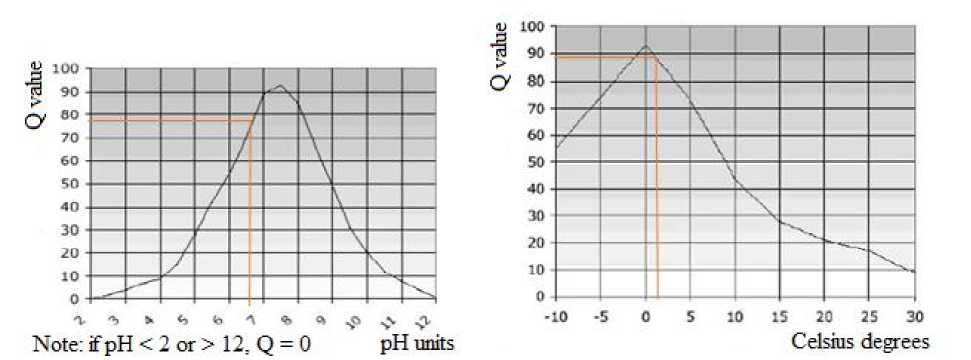
Fig. 2. pH
Fig. 3. Temperature Variations

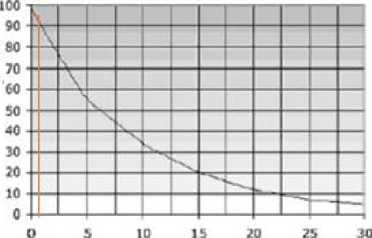
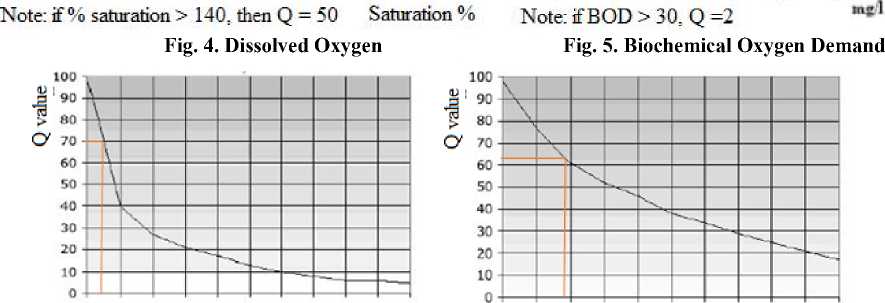
Fig. 7. Turbidity

Fig. 6. Total phosphates
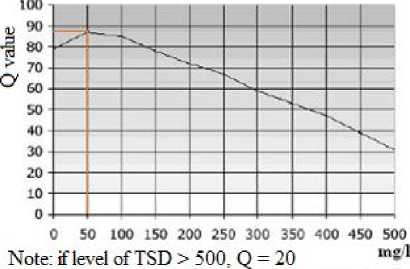
Fig. 8. Totally dissolved solids
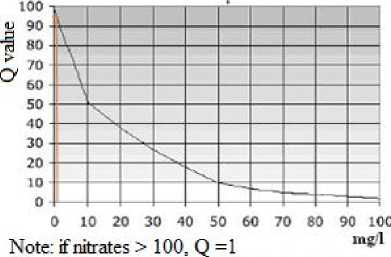
Fig. 9. Nitrates
Table 2
|
Indicator |
Test result |
Value Q |
Weight W |
Total |
|
BOD |
0,68 mg/l |
94 |
0.19 |
17.86 |
|
Dissolved oxygen |
66,2 % |
70 |
0.14 |
9.8 |
|
Nitrates |
1,35 mg/l |
92 |
0.12 |
11.04 |
|
pH |
6,79 unit pH |
77 |
0.12 |
9.24 |
|
Temperature variations |
2,36°C |
89 |
0.12 |
10.68 |
|
Totally dissolved solids |
50,1 mg/l |
87 |
0.12 |
10.44 |
|
Total phosphates |
0,38 mg/l |
70 |
0.1 |
7 |
|
Turbidity |
18,7 NTU |
80 |
0.09 |
7.2 |
|
I CA TOTAL |
83.26 (good quality) |
|||
|
Intervals of the water quality index |
Description |
|
0–25 |
Very thin |
|
26–50 |
Weak |
|
51–70 |
Medium |
|
71–90 |
Good |
|
91–100 |
Excellent |
Table 3
For the aggregation of values in a single water quality index (Tab. 2), the value for exceeding the representative interval value was used together with the weighting of the multiplication coefficient according to the formula below [4]:
^са = ^<Ж.
The values obtained refer to the table in Table 3 which allows the East Jiu water to be fed to the sampling point "Eastern Jiul after the confluence with the Taia River" in the good quality class.
Conclusions
The East Jiu river Basin, once highly industrialized, exerts major pressures on water quality. With the closure of mining operations in the area, these pressures have diminished over time, and water tends to improve in terms of quality but diversification of economic activities, population growth, waste, car traffic and unsustainable farming practices threaten the quality of East Jiu. From the analysis of the quality of the water in the East Jiu with the help of the water quality index, a good water quality results, but it is worth mentioning that water sampling took place after a period of abundant precipitation, reducing the water quality through the dilution phenomenon.
Список литературы Identification of the sources generating impact on the water quality of the East Jiu basin
- Fodor D. Mining and the environment, Corvin Publishing House, Deva, Romania, 2015.
- Toth L., Pasculescu V.M. Industrial and household wastewater treatment, Focus Publishing House, Romania, 2016;
- Lazar M., Dumitrescu I. Anthropic impact on the environment, Universitas Publishing House, Romania, 2006.
- Lazar, M. The rehabilitation of the degraded lands, Universitas Publishing House, Romania, 2010.
- Tutuianu O. Assessing and reporting environmental performance environmental indicators, AGIR Publishing House, Bucharest, Romania 2006.
- Ujvări I. The geography of Romania's waters, Scientific Publishing House, Romania.
- http://www.greenpeace.org/romania/ro/campanii/rosiamontana/descriere/.
- https://ro.wikipedia.org/wiki/R%C3%A2ul_Jiul_de_Est

